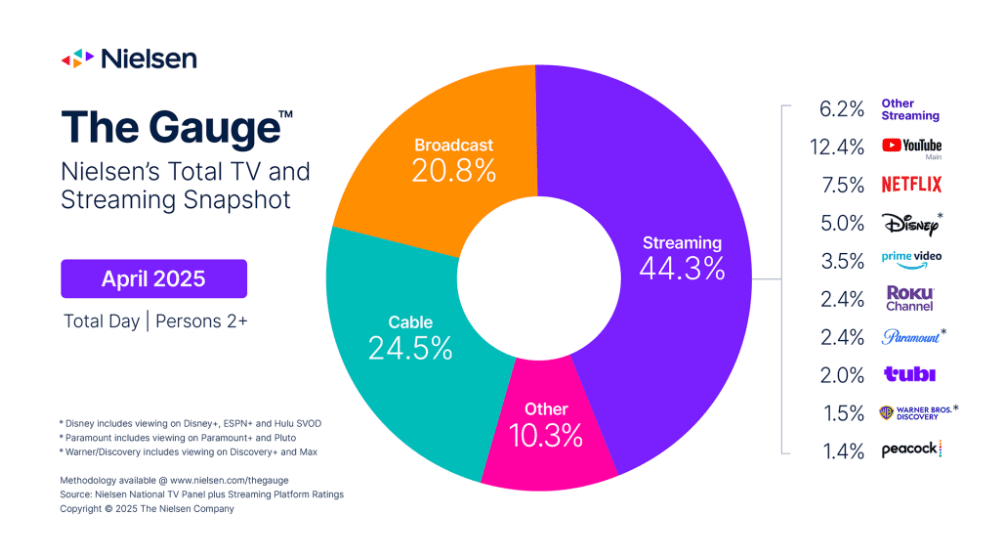Streaming captured its highest share of total television viewing ever in April and according to Nielsen, streaming made up 44.3% of all TV consumption, up from 43.8% in March. That growth alone would be newsworthy, but the real story is the continued dominance of YouTube, which reached an all-time high of 12.4% of total TV viewing.
That number reflects only YouTube usage on television screens. It does not include mobile, desktop, or even YouTube TV. This is not just a platform gaining ground. It is a platform pulling away from the rest of the field. Since passing Disney in February, YouTube has steadily increased its lead and is now approaching performance levels not seen since NBCUniversal’s Olympic spike in August 2023. Unlike that one-time surge, YouTube’s climb looks permanent.

Multi-Platform Hits Are Driving Streaming Growth
The broader streaming ecosystem also benefits from smart content distribution. ABC’s Grey’s Anatomy logged 3.9 billion minutes of viewing across Hulu and Netflix. The latest season is streaming exclusively on Hulu, but that season accounted for just 3% of episodes and delivered 10% of total viewership. Most of the consumption still comes from Netflix, which carries about 60% of the show’s streaming minutes.
Max saw similar success with The White Lotus. The HBO drama pulled in 3.7 billion viewing minutes in April and helped Warner Bros Discovery maintain a 1.5% share of total television time. These results show the impact of strategic placement across both traditional and digital platforms.
This is not about cannibalization. It is about extending the lifecycle and scale of content through smart windowing and wide distribution.
Roku’s Reign in the FAST Lane
The Roku Channel continues to show strong growth. It reached 2.4% of TV usage in April, up 0.2 points from March. Since November, usage is up 21%. Year over year, it has grown by 67%, the largest increase of any distributor measured by Nielsen.
This momentum correlates directly with Roku’s decision to include premium services like Max inside its interface. The integration is working. Viewers are staying within the Roku ecosystem longer, and advertisers are taking note.
Tubi, once considered the leading FAST platform, is now trailing. The Roku Channel has taken the lead, and the margin is widening.
Broadcast’s Lifeline? Sports, Still.
While streaming is surging, traditional TV is not disappearing overnight. Live sports continue to draw massive audiences. CBS brought in 18.3 million viewers for the Men’s NCAA Basketball Championship. The Masters final round also posted a 36% increase over last year, reaching 13 million viewers.
On cable, ESPN averaged 6.4 million viewers for its NFL Draft coverage. The NBA Playoffs delivered as well, with ESPN and TNT averaging 3.1 million and 2.8 million viewers per game, respectively.
Cable’s share climbed to 24.5% in April. Broadcast increased slightly to 20.8%. But those numbers are driven almost entirely by live events. They are spikes, not signals of long-term stability.
The Take
YouTube is no longer one of many players in connected television. It is the dominant platform. What was once a crowded field is now consolidating around one clear leader.
This matters for two reasons. First, YouTube’s growth is not powered by a single franchise or a limited window. It is consistent. It is platform-wide. And it is happening without including mobile or YouTube TV data. Second, it changes the conversation around scale. When we talk about who has reach, who can deliver results at volume, and who is setting the rules for what connected TV looks like, the answer is increasingly YouTube.
That does not mean other platforms cannot win. But it does mean they need to think beyond content. Distribution is now just as critical as production. Grey’s Anatomy and The White Lotus are not just good shows. They are well-placed shows.
Streaming is no longer an alternative to television. It is the primary viewing experience for nearly half the audience. And right now, YouTube is defining what that experience looks like.







